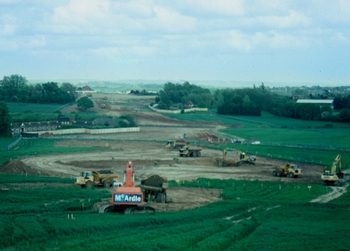Leda Cottages, Westwell, Kent - Integrated Site Report
Oxford Archaeology (South), 2009. (updated 2017) https://doi.org/10.5284/1044815. How to cite using this DOI
Data copyright © High Speed 1 unless otherwise stated
This work is licensed under the ADS Terms of Use and Access.
Primary contact
Stuart
Foreman
Senior Project Manager
Oxford Archaeology (South)
Janus House
Osney Mead
Oxford
OX2 0ES
UK
Tel: 01865 263800
Fax: 01865 793496
Resource identifiers
- ADS Collection: 2459
- DOI:https://doi.org/10.5284/1044815
- How to cite using this DOI
Introduction

As part of an extensive programme of archaeological investigation carried out in advance of the construction of the Channel Tunnel Rail Link (CTRL), Oxford Archaeology (formerly Oxford Archaeological Unit) was commissioned to undertake a watching brief between Westwell Leacon and Tutt Hill in Kent. In the course of the watching brief, a concentration of archaeological features was exposed, west of Leda Cottages, Westwell, and subjected to detailed excavation. The excavation was carried out between July and September 2001, under the project management of Rail Link Engineering on behalf of Union Railways (South) Limited (a subsidiary of London and Continental Railways).
The features recorded were principally of Roman date. However, a small assemblage of redeposited worked flint, ranging in date from the Mesolithic to the Bronze Age, was also recovered, suggesting some prehistoric activity in the area.
Late pre-Roman Iron Age occupation was identified in the form of a rectilinear enclosure, with two apparent entrances. Two four-post structures, yielding evidence of crop processing, and a few pits were identified within the enclosure. Evidence for iron smelting activity was also tentatively attributed to this period, based on very limited evidence. One furnace was located within the main enclosure but the main cluster of features associated with this activity was situated 100 m to the north, in close proximity to the present-day stream. It was composed of four furnaces and three pits. Dating evidence associated with ironworking was very tenuous but quantities of slag found in fills of features of all phases indicate that this activity carried on throughout the three phases of occupation.
A second rectangular enclosure was dug, possibly in the second half of the 1st century AD, respecting the alignment of the earlier one, which was therefore probably still in use. There were also a few pits and postholes, a waterhole and a flint lined structure. A series of re-cuts, dated to the 2nd century AD obliterated most of the original ditches of this second enclosure. The last phase of occupation, from the second half of the 2nd century to AD 270, produced the largest assemblages of pottery. It was mostly represented by a series of discrete features including a rectangular clay structure, several possible rubbish pits and postholes and two waterholes. The site appears to have been abandoned around AD 250-270.
The fieldwork events incorporated in this report are:
- West of Leda Cottages Watching Brief - Area 430 (ARC WB430/83+200) - Watching Brief






